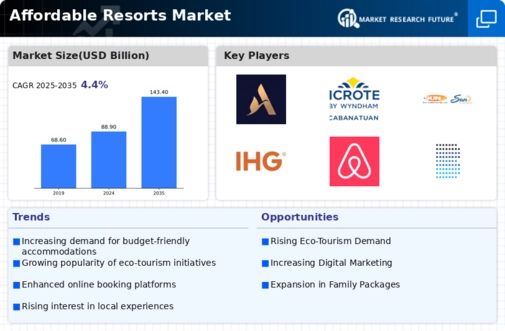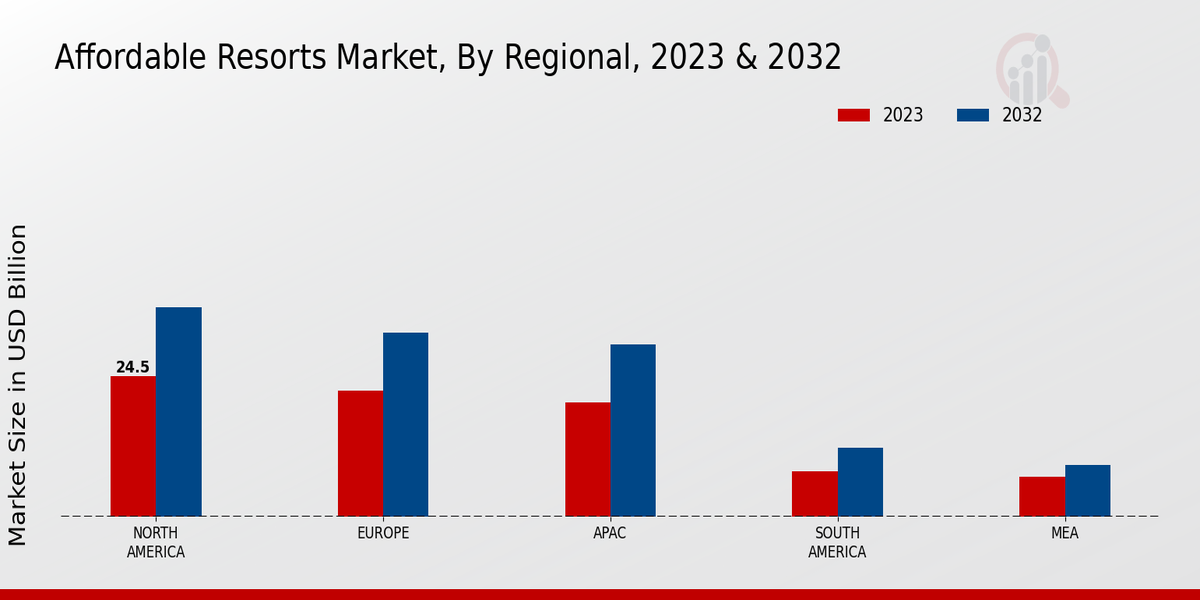Increased Domestic Travel
The Global Affordable Resorts Market Industry benefits from a notable rise in domestic travel as individuals seek cost-effective vacation options closer to home. This trend is particularly pronounced in regions where international travel may be limited or perceived as less accessible. As travelers prioritize convenience and affordability, resorts that offer attractive packages and amenities are likely to thrive. The market's projected growth to 143.4 USD Billion by 2035 suggests that domestic tourism will continue to play a pivotal role in shaping the landscape of affordable resorts, allowing for a more sustainable and resilient industry.
Market Growth Projections
The Global Affordable Resorts Market Industry is projected to experience substantial growth, with estimates indicating a rise from 88.9 USD Billion in 2024 to 143.4 USD Billion by 2035. This growth trajectory suggests a compound annual growth rate (CAGR) of 4.44% from 2025 to 2035. Such projections highlight the increasing demand for affordable travel options as more consumers seek budget-friendly accommodations. The market's expansion is likely to be influenced by various factors, including demographic shifts, evolving travel preferences, and the ongoing development of affordable resort offerings.
Diverse Consumer Preferences
The Global Affordable Resorts Market Industry is characterized by diverse consumer preferences, which drive the demand for a variety of accommodation styles and experiences. Travelers are increasingly seeking unique and personalized experiences that cater to their specific interests, whether it be adventure, relaxation, or cultural immersion. This diversity encourages resorts to innovate and offer tailored packages that appeal to different demographics. As the market continues to grow, the ability to adapt to changing consumer preferences will be crucial for affordable resorts aiming to capture a larger share of the market.
Sustainable Tourism Practices
Sustainability is becoming increasingly important in the Global Affordable Resorts Market Industry, as consumers show a preference for eco-friendly accommodations. Resorts that adopt sustainable practices, such as reducing waste and conserving energy, appeal to environmentally conscious travelers. This trend not only enhances the reputation of affordable resorts but also aligns with the growing demand for responsible tourism. As the market evolves, resorts that prioritize sustainability may experience a competitive advantage, attracting a segment of travelers willing to pay a premium for eco-friendly options. This shift could further drive market growth and innovation.
Rising Middle-Class Population
The Global Affordable Resorts Market Industry is experiencing growth driven by an expanding middle-class population worldwide. As more individuals attain disposable income, the demand for affordable vacation options increases. In 2024, the market is valued at 88.9 USD Billion, reflecting a shift in consumer preferences towards budget-friendly accommodations. This trend is particularly evident in emerging economies where the middle class is projected to grow significantly. The increased willingness to travel among this demographic indicates a robust potential for affordable resorts, which are likely to cater to diverse preferences and budgets, thereby enhancing market dynamics.
Technological Advancements in Booking
Technological advancements are reshaping the Global Affordable Resorts Market Industry by streamlining the booking process and enhancing customer experiences. Online platforms and mobile applications allow consumers to compare prices, read reviews, and make reservations with ease. This accessibility encourages more travelers to explore affordable resort options, thereby expanding the market. The integration of artificial intelligence and personalized marketing strategies further enhances customer engagement, making it easier for resorts to attract budget-conscious travelers. As the industry evolves, these technological innovations are likely to contribute to the projected CAGR of 4.44% from 2025 to 2035.














